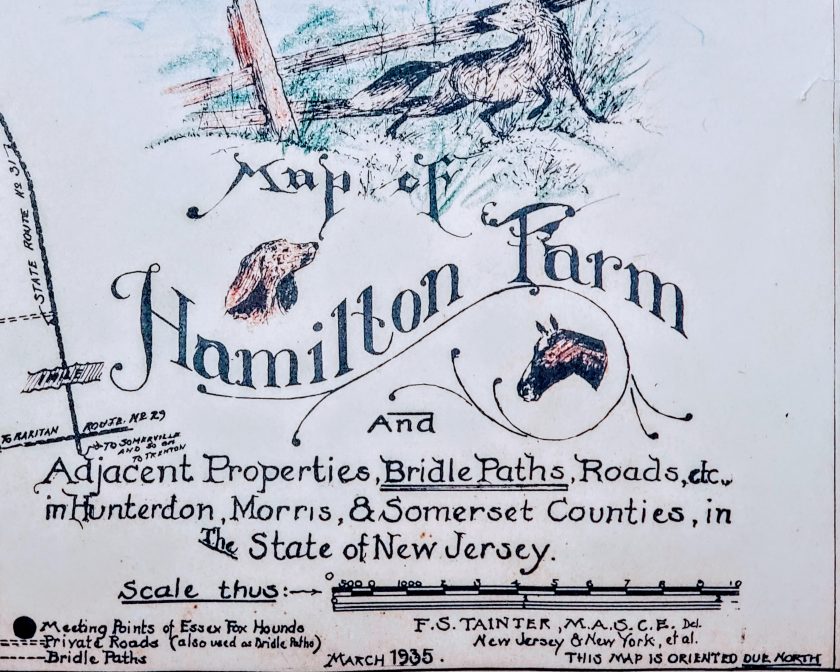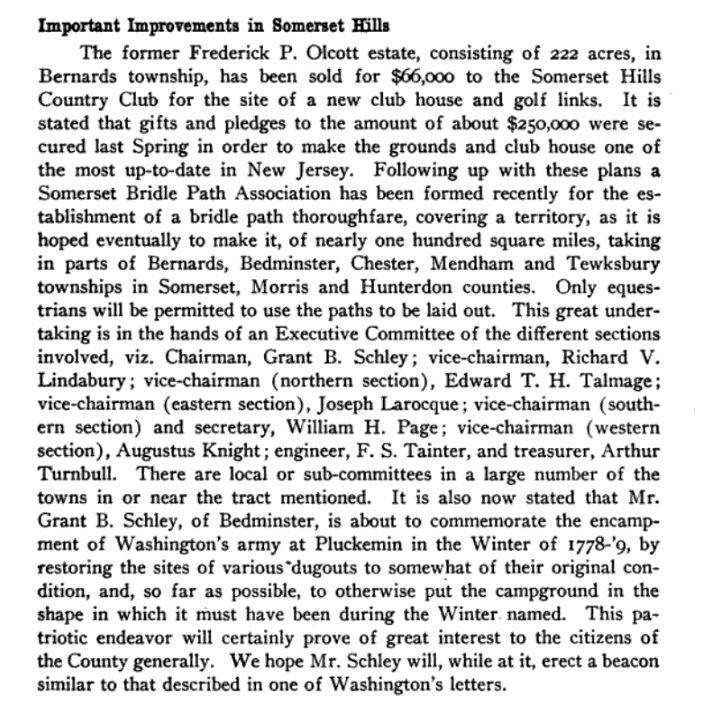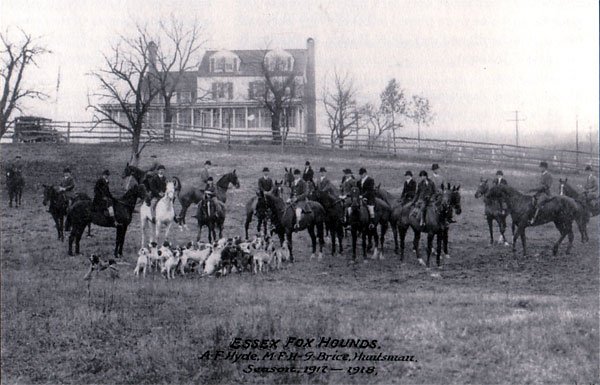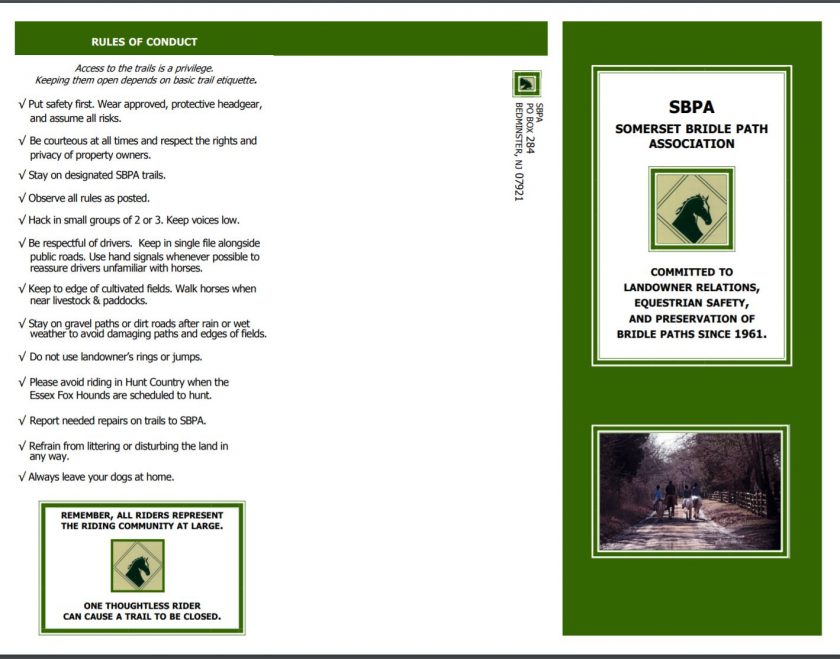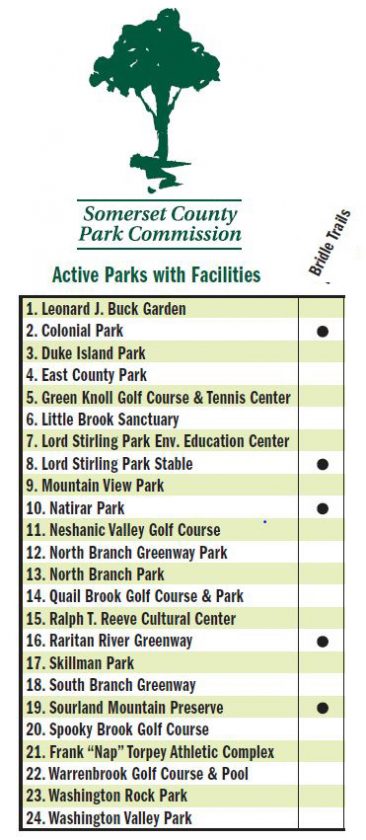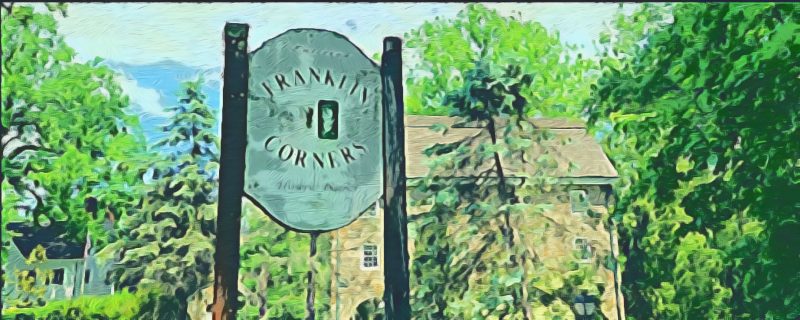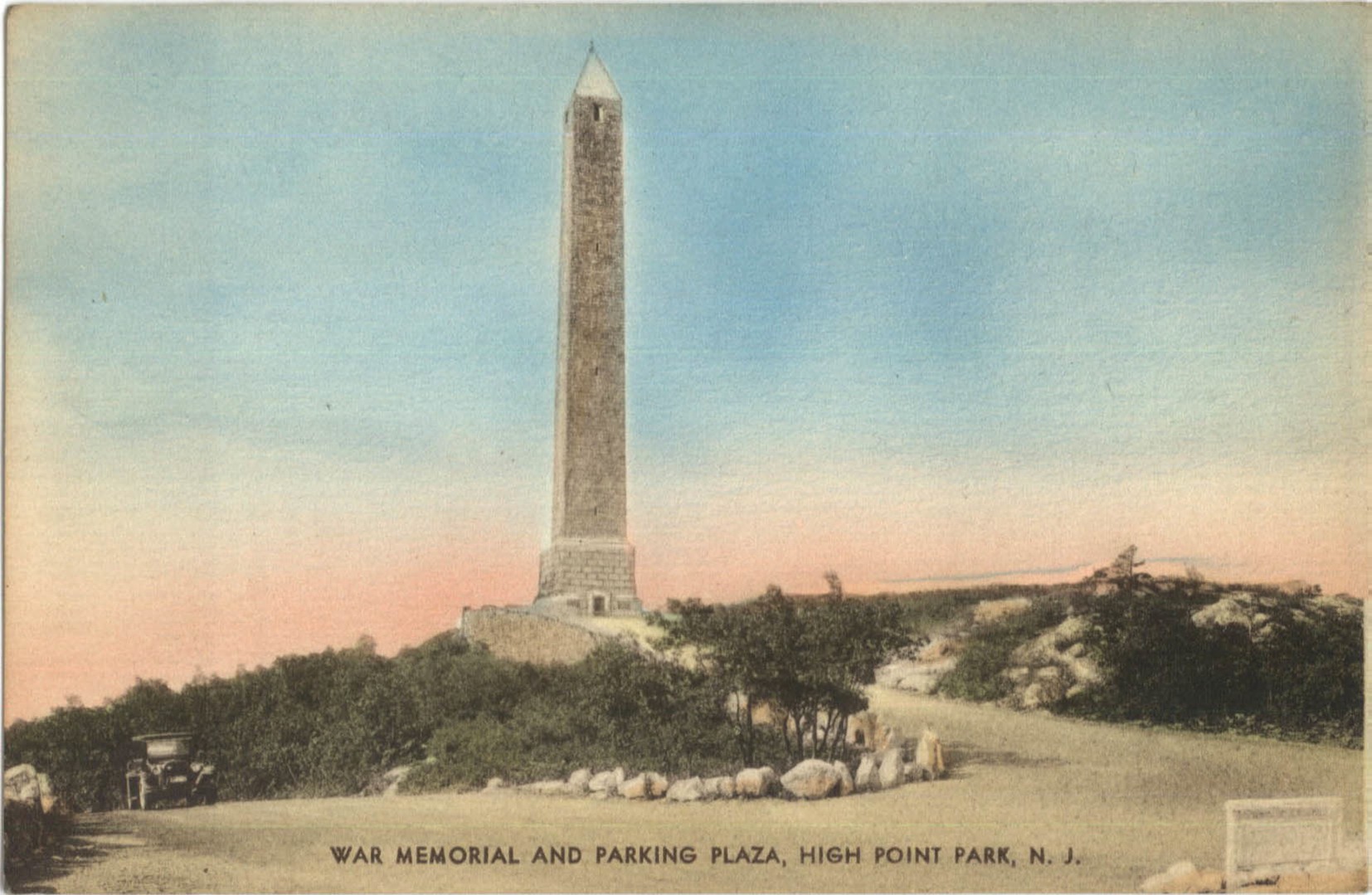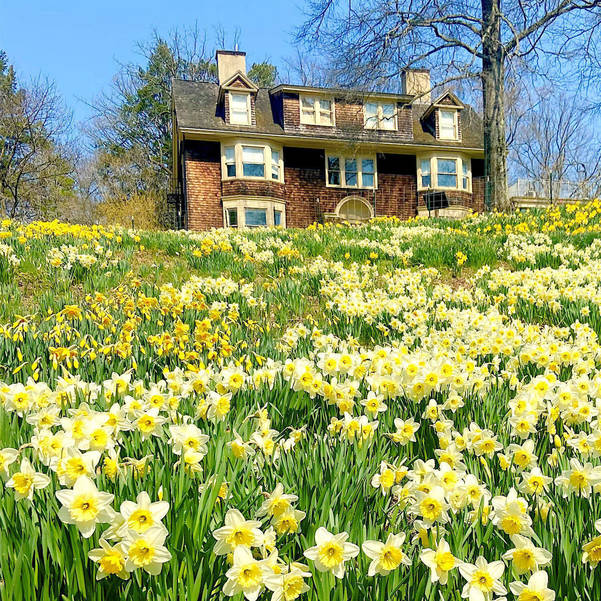NOTE: As with all Mr. Local History retrospectives, we often update the post when we learn stories and are sent photos from our community. We will continue to grow this piece as information becomes available.
History
What many people don’t know is that the Somerset Hills in northern Somerset County, New Jersey is STILL one of the largest equine communities in the United States. Bedminster, New Vernon, Peapack, Gladstone and Tewksbury are just some of the towns that dot the map where equestrian activity is still welcome. Bedminster still even has cinder roadways that are horse friendly.
A bridle path, also bridleway, equestrian trail, horse riding path, ride, bridle road, or horse trail, is a path, trail or a thoroughfare that is used by people riding on horses. For those new to equine nomenclature, a bridle is the headgear used to control a horse, consisting of buckled straps to which a bit and reins are attached. Hence, if your horse has a bridle on, they can proceed to a “bridle path.”
Trails originally created for use by horses often now serve a wider range of users, including equestrians, hikers, and cyclists. Such paths are either impassable for motorized vehicles, or vehicles are banned. In industrialized countries, most bridle paths are now primarily used for recreation. But in the Somerset Hills, bridle paths still serve an important role in our community.
Bridle paths are also important non-vehicular linkages, generally found on private property. This fragile resource, which has been fragmented by the construction of I-287 and I-78, should be noted for its historic value. Let’s take a look back at the history of bridle paths and equine history in the Somerset Hills.
The “Landed Gentry” Makes the Hills Their New Playground
Since the late 1800’s the vast space of the Somerset Hills was the lure to having horses in the area. Cinder roadways and a groomed set of paths acted as the equestrian roadways of the area. Whether you were out for a gentle ride or a high speed gallop, the Somerset Hills was the place to be.
In the early 1900’s, visits to the Somerset Hills was on the rise. With the railroad reaching Bernardsville in 1870, then extending to Far Hills, Peapack and Gladstone in 1890, the catalyst was in place to bring the masses…. and it did. Essex County had gotten too crowded so they flocked to Morristown and the surrounding area including the Somerset Hills.
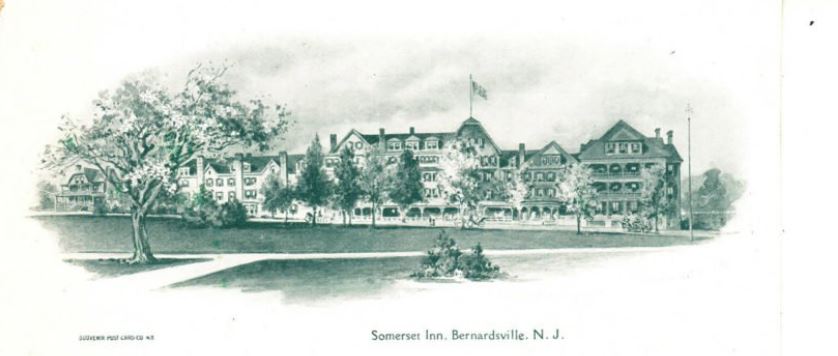
Another draw to the area was the famed Somerset Inn on the Bernardsville Mountain. Built by George Seney, the Inn served more like the unofficial tourist bureau as the wealthy came out for a look and felt it was the perfect spot without having to travel to Newport or the Hampton. With plenty of space for riding, it was a natural fit for equestrian activities.
Charles Pfizer Brings Essex Hounds To the Somerset Hills
With the Essex Hunt Club firmly established in Somerset County, in February 1913, the Essex Fox Hounds was incorporated with a dedicated purpose to promote fox hunting in Somerset County. Hunters had simply run out of space in Llewellyn Park and the surrounding West Orange /Montclair area of Essex County (hence the name).
The Essex Hunt, originally sponsored by the Essex Hunt Club, was founded originally in 1870 in Montclair, New Jersey. Known for being what’s called a drag hunt (where the scent of the fox was dragged over the course), the event was at the famed Essex Hunt Club.
Soon after the Essex Hounds Club incorporated, a new clubhouse was built along with a new set of kennels. Previously known as the old Miller Farm, the Essex Hunt Club is now situated off Route 206 on Holland Road in Gladstone. As they say…..the rest is history!
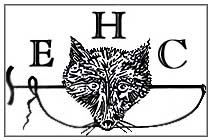
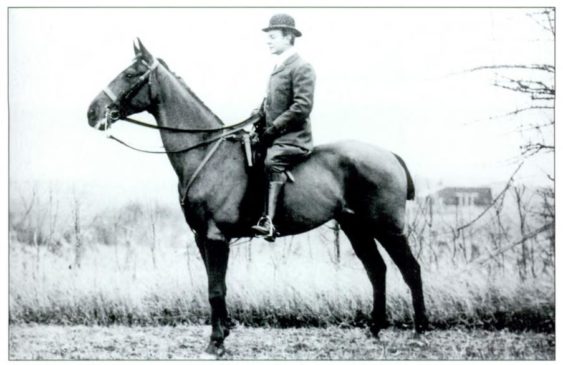
1920’s – Bridle Path Expansion
When the MLH Project found this 1925 edition of the area’s bridle paths, we felt like we’d found gold. There is so much rich history tied to what many call the “Sport of Kings” and the Somerset Hills was the perfect place to establish a broad network of a horse highway system that served everyone from recreational riders to avid fox hunters.
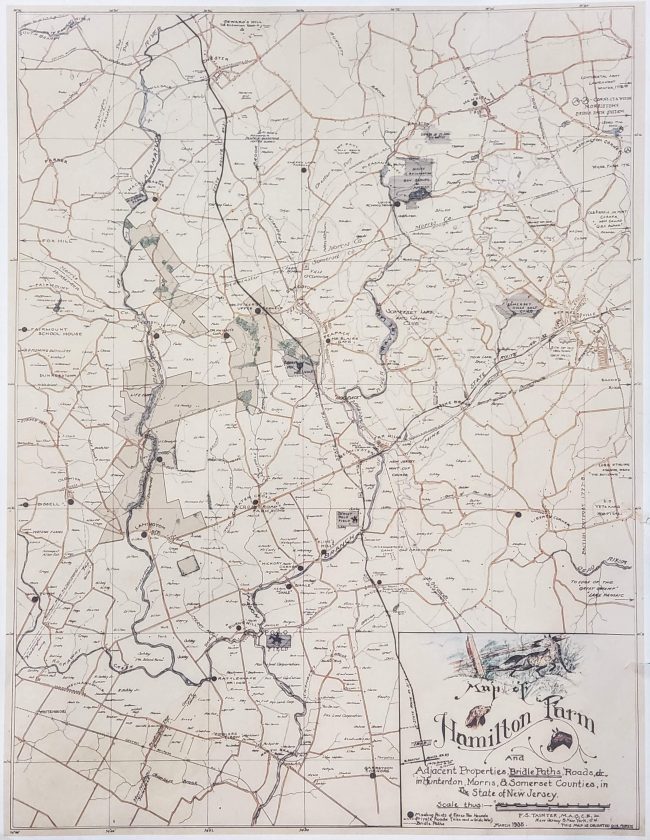
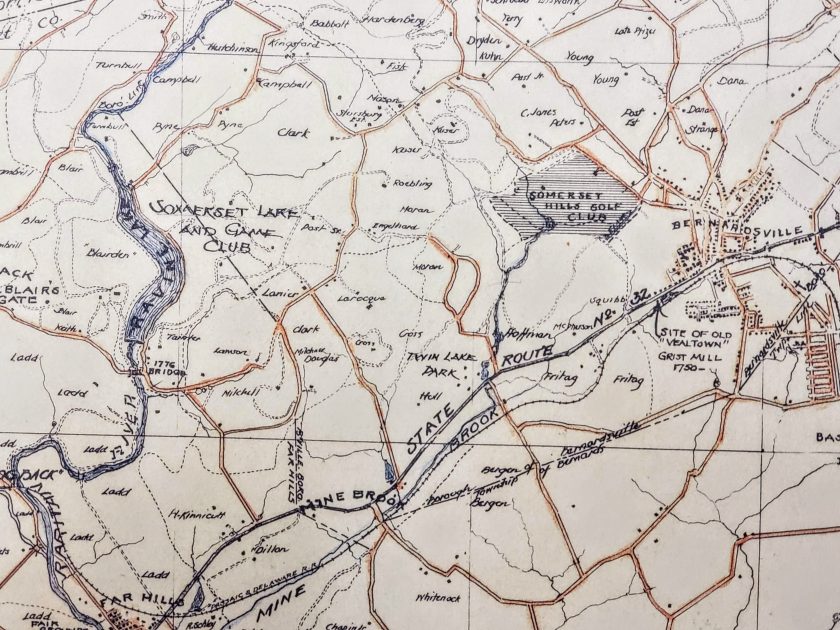
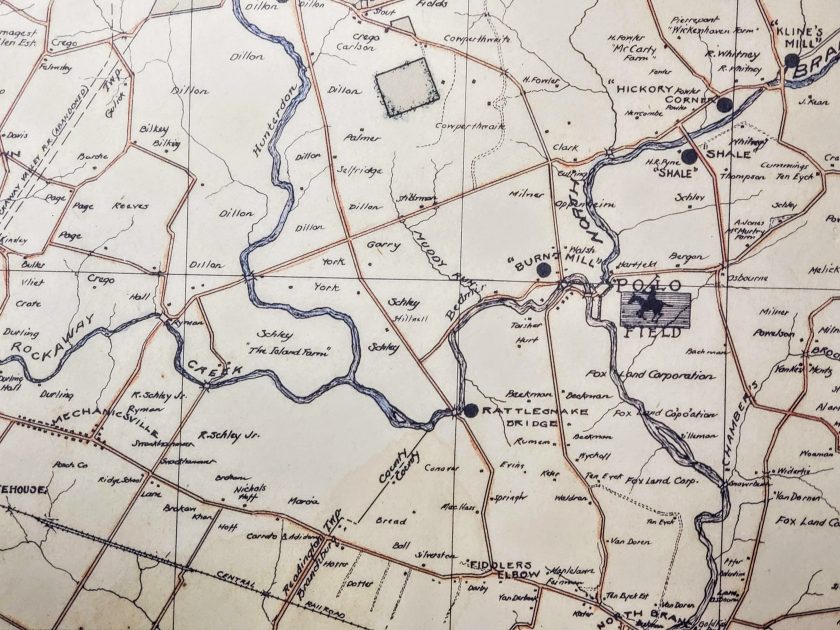
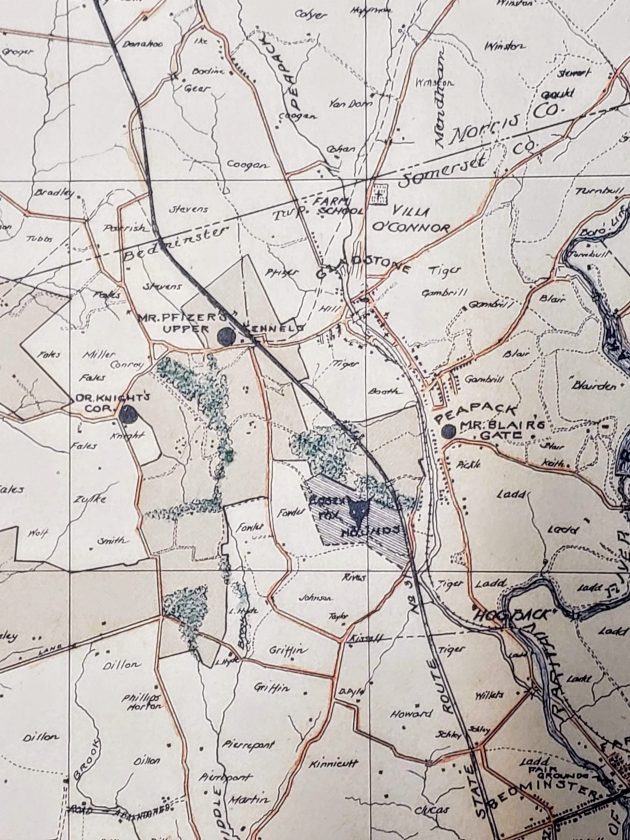
Somerset Hills Bridle Paths
Local regulation is generally not a useful tool in the quest to protect and enhance equestrian trail networks. Rather than protecting the bridle path system, regulatory schemes may actually discourage continued willingness of property owners to permit equestrian use of bridle paths. The local Planning Board knows these bridle path networks and strategies for their retention and preservation which are sensitive to the concerns of private landowners.
Maintaining the bridle trail network is fundamental to continuing the equestrian way of life that plays an important role in maintaining Bedminster’s beautiful countryside. Thus, new neighbors should be assisted in recognizing this unique infrastructure and respect its value to all residents. The Township should assist in the creation of new trail linkages and expansion of equestrian opportunities. The Somerset Bridle Path Association (SBPA) and the Lamington Equestrian Association, Inc. are organizations that promote trail riding for horse owners, and work with Bedminster to protect, maintain and expand equestrian trails in the Bedminster countryside.
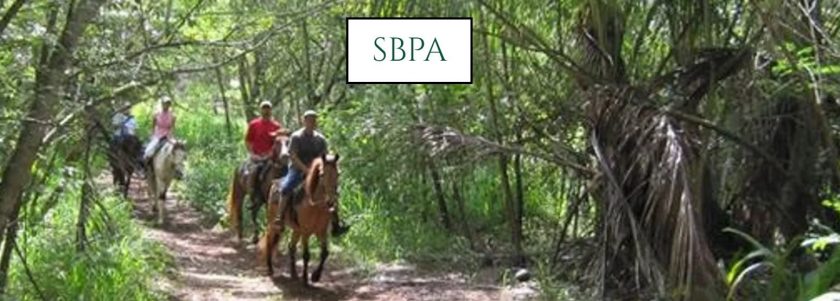
There are more than 200 miles of private trails governed by two groups, the Morris and Somerset Bridle Path Associations. The Somerset Bridle Path Association (SBPA) works tirelessly to help keep bridle paths open as landowners prefer to keep their property private. The Association is serving as a link between land owners and riders, with the organization working to preserve the equestrian character of Bedminster and environs by keeping acreage open to horses wherever possible.
It’s definitely a two-way street, “a system that benefits everybody.”
Former SBPA President Chris Herold
SBPA emphasizes that only those whose horses are stabled in the area are eligible for membership so they can ride on private property (the group’s purview does not include unpaved public roads open to all). In return, riders must be respectful of the turf on which their mounts are treading.
Time, development, deer fencing and an influx of population have changed the area, but the SBPA works to preserve traditions while reassuring land owners who open their property to riders.
“Our goal is to help keep land open so that riders can continue to have use of these beautiful trails,”
Diane Holtaway – Vice President of SBPA
The Somerset association was formed in 1916. It is supported by the cooperation of landowners, who give permission for the use of their property, and by subscriptions and donations from the association’s 300 members, The suggested minimum donation for an active family is $25 a year. A detailed bridle‐path map is available from the group for $5. Both associations work closely with the local police so as to restrict the paths to riders and those authorized persons who carry identification cards and buttons.
Membership in the organization, which carries $2 million in insurance, is $40. For more information, go to sbpatrails.org.
The other association, the Morris County Association was founded in 1909, and a complete bridle system has gradually evolved with support of over 400 members.
Lord Stirling Stable Bridle Paths
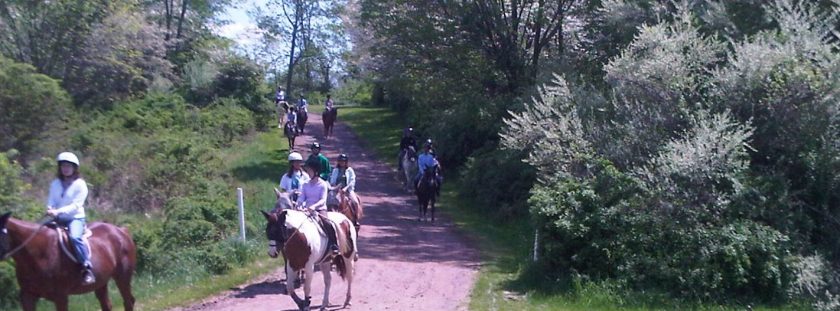
In 1968 the Somerset County Parks Commission purchased what became the Somerset County Riding Stables in Basking Ridge. Harold Case was the first manager along with 23 horses and three men. There were five instructors.
With 4 1/2 miles of trails, the horses are chosen for their temperament and suitability for what they do. But recently, due to the COVID-19 pandemic, 27 horses have been sold to Pond Hill Horse Ranch in Vermont and the entire organization is struggling to find out what’s next.
The financial crunch from the pandemic has not only closed the Lord Stirling Stables in Basking Ridge for the rest of 2020, but also resulted in the sale of 27 horses kept at the shuttered Somerset County Park facility. For the balance of 2020, it’s only boarding horses at Lord Stirling Stables. There are currently 21 horses being boarded by private owners. Reports have stated that the Lord Stirling Stable has been losing upwards of a half million dollars a year for the last decade. Somerset County supports the stables thru revenue from the county’s golf course system. No full-time stable employees have been furloughed, but all part-timers were released according to Parks Director Geoff Soriano.
Fairview Farm Bridle Paths
The Upper Raritan Watershed’s headquarters is on the beautiful Fairview Farm off Larger Cross Road in Bedminster. The association has over 4.5 miles of horse trails to explore.
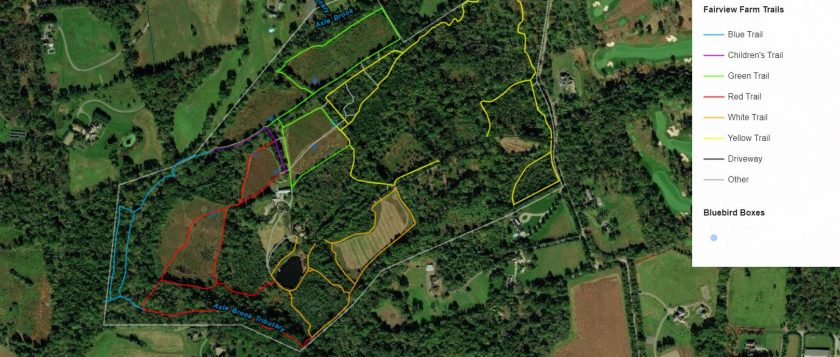
The URWA’s Fairview Farm is at 2121 Larger Cross Rd, Bedminster, NJ 07921
Somerset County Park Commission Bridle Paths
Additional Equine Points of Interest
The USET Foundation in Gladstone
In addition to bridle paths, many people don’t know that the Hamilton Farm, which was once one of the largest farms in the state had a stable complex that was so sophisticated that it served as a military hospital during World War II. After it had shown so much promise, the facility now serves as the home to the United States Equestrian Team Foundation.
The Hamilton Farm was a 5,000 acre farm assembled by Diamond Jim – James Cox Brady back in 1911. The Hamilton Farm stables was coined “the million dollar coach barn” built in 1916 and contained 41 stalls. In 1961 the stable became the home of the United States Equestrian Team.
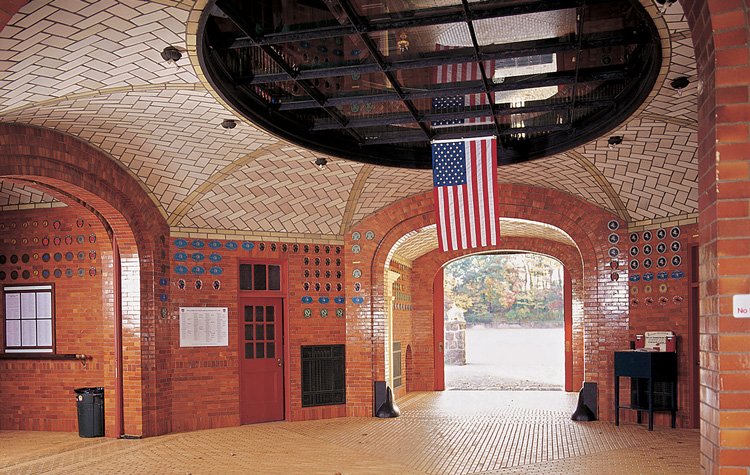
Far Hills Steeplechase
The Far Hills Race Meeting Reaches its 100th Anniversary in 2020
If you talk about horses in the Somerset Hills you can’t ignore the Far Hills Race Meeting that celebrates it’s 100th running in 2020. Every year Far Hills Township swells over 40 times it’s normal size, from approximately 857 to almost 30,000, making it the largest population in Somerset County on this day each year. What started as Charles Pfizer’s Farmers Day celebration back in in 1915 has become quite the show.
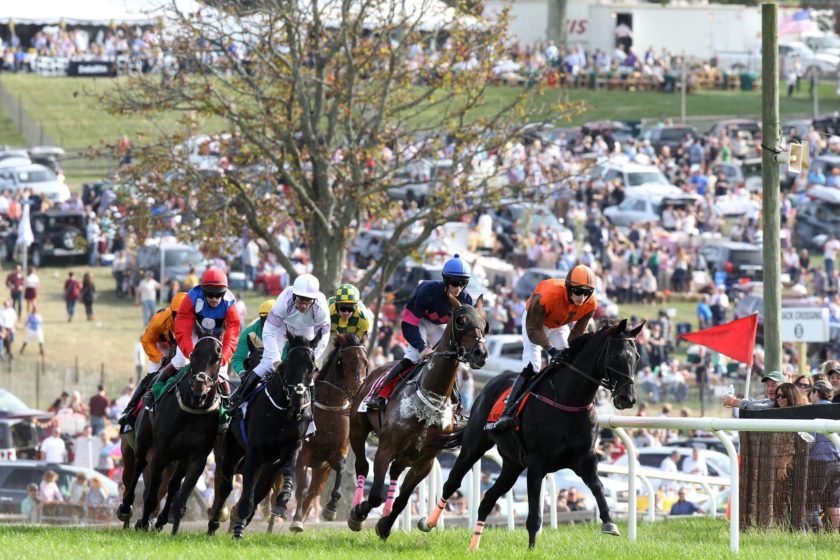
Longtime Far Hills resident John Von Stade quoted a former Far Hills official: “Fifty percent of the people come to see; 50 percent come to be seen.”
Comments?
Share below if you have any comments or stories you’d like to share.
MLH articles and Additional Info:
- The Essex Hunt Club and its ties to the Far Hills Race
- Jacqueline Kennedy and her time in the Somerset Hills
- The Friends of the Lord Stirling Stable
- Lord Stirling Park Map – Bernards Twp
- The Far Hills Race Meeting – History
- Shannon Hill Polo Club – Basking Ridge
- Tewksbury Trail Association has been successful in providing a network of trails for equestrian enthusiasts.
- Gravel Roads -shares online maps of gravel roads that are suited for riding. Here’s Bedminster
In Nearby Morris County
Harding Bridle Paths
The Harding Township/Green Village Bridle Path Association is a nonprofit organization that has existed since the 1960s. The Harding Township/Green Village Bridle Path Association has been maintaining the nine bridle paths as part of a much larger system of trails throughout the area, said past association president, Linda Vola. Responsibility for upkeep of the trails now owned by the Harding Land Trust will pass to HLT’s trustees and staff.

In 2003, Harding Township, Helen Platt, president of Bridle Paths Inc. (BPI), signed documents transferring part of the organization’s network of equestrian trails in the township to the Harding Land Trust (HLT).
“These trails have enabled riders to travel across the township in a relatively automobile-free environment over several generations.”
Penny Hinkle, executive director of the Harding Land Trust.
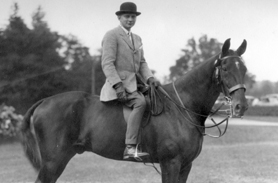
Hartley Dodge, from the Winchester Dodge legacy, an early 20th century industrialist and philanthropist who lived in the township, used to enjoy driving his horse carts to his friends’ houses, which probably included all the major landowners in town.
